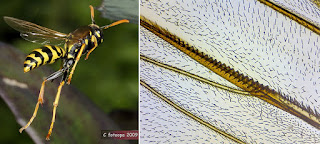Generally speaking, insects have two sets
of wings. Front wings and hind wings. As different insect groups evolved there
have been many modifications to this configuration. From a bioinspiration
perspective, it is interesting to consider how many possibilities have been
explored through the process of evolution. For example, dragonfly wings are
kept in a constant position perpendicular to the body at all times.
 |
| Dragonfly - Image credit: Luc Viatour |
Other insects, such as cockroaches, position the wings flat over the back of their body when not in use. Ants, bees, and wasps have
hook-like structures (called hamuli) on the front side of the hind wing that
fit in a groove on the back side of the front wing linking the two wings during
flight.
 |
| Wasp and close up of the junction between the front and hind wings showing the hook-like hamuli (Image credit) |
Beetles have evolved a different wing
configuration. The front wings have evolved to be wing covers for the hind
wings – they are not used for flight at all. The front wings of beetles, also
known as elytra (singular = elytron), are hardened structures that lift
up and out of the way when the beetle takes flight. The hind wings are tucked
up and out of the way underneath the elytra, like a neatly folded shirt packed in your suit case. The wings, however, are spring loaded so they are
ready for action when the elytra are lifted up.
 |
| June beetle (Phyllophaga sp.) getting ready for flight - elytra lifted up with hind wings unfolding (Image credit: Bev Wigney) |
Now there is a useful mechanism. Compact
structures that can go from being neatly folded, out of the way under a protective covering, to springing into position to propel an insect in flight. Imagine flying
down the street for coffee with wings that self-deployed from your backpack.
Okay, probably not the current goal for beetle wing bioinspiration - but think
of the possibilities. A group of Japanese scientists has already started.
Using microcomputed tomography in combination with synthetically made translucent elytra, Saito et al. (2017) studied how
ladybird beetles fold their wings up under their elytra. I could go through the
play-by-play but I highly recommend you watch the video. The folding action is aided by movements
of the abdomen in combination with supporting structures that create friction. The
idea is that different aspects of the wing, such as the wing veins, are shaped
in a particular way that allows the wing to fold while also spring loading it
for deployment. Maybe some of you saw this segment on 60 minutes – one of many ways engineers can draw inspiration from insect folding and
deployment mechanisms.
Of course, Saito and colleagues were not
the first to notice the incredible wing folding mechanisms of beetles. One of
the earliest pioneers of wing folding in beetles was William Trowbridge Merrifield Forbes (1885 – 1968). W.T.M. Forbes published many papers on
beetles and butterflies. In 1924, he published a paper titled “How a beetle folds its wings” where he provided detailed descriptions of wing folding mechanisms based on
dried specimens he started collecting as a child. In 1926, Forbes followed up
with “The wing folding patterns of the Coleoptera” (Coleoptera
= the scientific name for beetles), which was a more extensive treatise using
specimens from the Cornell University Insect Collection. In this paper,
he described a ‘fundamental plan’ such that “The folding patterns of practically all beetles prove to be
derivable by relatively simple modifications from a single fundamental plan…”
(p. 42). Inferring this plan from the specimens available reveals the flexible and ingenious mind of an evolutionary morphologist. He went on to describe this plan,
and then remarked on the deviations exhibited by all the different beetle
groups, of which there are many. The paper was 27 pages long and the last three
words were: (To be continued).
 |
| Figure 1 from Forbes (1926) - Journal of the New York Entomological Society 34, pgs. 42-68). PDF courtesy of the Biodiversity Heritage Library. |
Forbes’ publications also included a bit of
scientific sleuthing. Unlike my scientific sleuthing, which typically goes back
to the early 1900’s (although last time it went back to the early 1700’s), Forbes
took an investigation of a silkworm moth back to Pliny the Elder (AD 77) and Aristotle (BC 384 – 322). One comment I found particularly
interesting was: “Pliny is of course beyond saving by any mere definition”.
I would love nothing more than to trade in
my car for a pair of self-deployable, beetle inspired wings to meet up with Pliny the Elder.

No comments:
Post a Comment